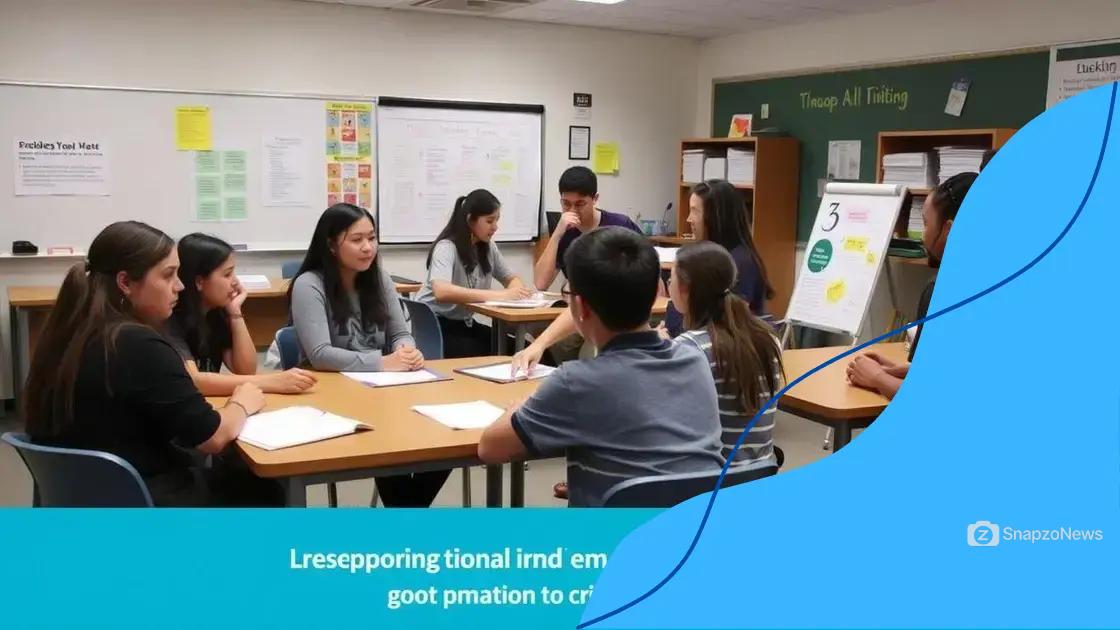New approaches to teaching critical thinking

Teaching critical thinking effectively involves overcoming challenges like traditional assessment methods and fostering a supportive environment, while employing innovative strategies to engage students in deeper analysis and problem-solving.
New approaches to teaching critical thinking are essential in today’s fast-paced world. Have you considered how these strategies might reshape your classroom dynamics and student outcomes? Let’s explore some compelling methods.
Understanding critical thinking in education
Understanding critical thinking in education is vital for preparing students for real-world challenges. This concept encourages students to analyze, evaluate, and create solutions rather than merely memorizing information.
As we explore this essential skill, it is essential to recognize its components. Critical thinking can be broken down into several key areas which help in promoting deeper understanding.
Key Components of Critical Thinking
When teaching critical thinking, consider focusing on these components:
- Analysis: Students learn to dissect information and understand its meaning.
- Evaluation: Encourage them to think about the validity of sources and arguments.
- Inference: Teach them to draw logical conclusions based on evidence.
- Problem-solving: Help students apply their thoughts to find solutions.
Integrating critical thinking in the classroom leads to improved student outcomes. For instance, discussions can help students articulate their thoughts and consider different perspectives. This is particularly effective in group activities where they share their viewpoints.
As they engage with peers, students refine their skills in a supportive environment. Moreover, educators can utilize various methods to stimulate these conversations, such as open-ended questions or real-world scenarios.
Encouraging a Critical Thinking Mindset
Creating a culture that prioritizes critical thinking is key. Teachers should model these skills, showing how they approach problems and make decisions. When students see these practices in action, they are more likely to adopt them.
Furthermore, providing feedback is crucial. When students receive constructive criticism on their reasoning, they understand areas for improvement. This helps them develop a growth mindset and enhances their ability to think critically.
In conclusion, understanding and integrating critical thinking in education empowers students to become independent thinkers, ready to tackle complex issues. By focusing on the key components and fostering an open environment, teachers can significantly enhance students’ learning experiences.
Innovative teaching strategies for critical thinking
Innovative teaching strategies for critical thinking are essential for engaging students in meaningful learning. These methods help students develop their ability to analyze information and solve problems effectively.
One approach is to incorporate project-based learning. This technique allows students to work on real-world problems, encouraging them to apply their knowledge creatively. As they tackle challenges, they learn to think critically and collaborate with peers.
Technology Integration
Using technology can also enhance critical thinking skills. Digital tools can provide interactive experiences that promote analysis and evaluation.
- Simulations: Students can engage in virtual scenarios that require decision-making.
- Online discussions: Platforms that facilitate debates help them articulate and defend their views.
- Research projects: Encouraging students to explore topics online improves their evaluation skills.
Collaborative learning is another strategy that fosters critical thinking. Group work allows students to share diverse perspectives and brainstorm solutions together. When students discuss ideas in a team, they learn to respect different viewpoints.
Moreover, incorporating open-ended questions in discussions stimulates deeper thinking. Instead of simple yes or no answers, these questions encourage students to elaborate on their reasoning.
Real-World Connections
Connecting lessons to real-world contexts makes critical thinking relevant. Teachers can present case studies or current events, prompting students to analyze information critically. By relating content to their lives, students see the value of thinking deeply about what they learn.
Encouraging reflection is also important. After completing projects or discussions, teachers can ask students to evaluate their learning process. This promotes metacognition and helps them understand their thought processes.
Overall, utilizing innovative teaching strategies for critical thinking enriches the educational experience. By engaging students in various ways, educators equip them with essential skills for their future endeavors.
Creating an environment that fosters critical thinking

Creating an environment that fosters critical thinking is essential for effective learning. A supportive atmosphere encourages students to express their ideas freely and engage deeply with the material.
One important aspect is providing a safe space for students to share their thoughts. They must feel comfortable asking questions and debating topics without fear of judgment. By promoting open communication, educators can significantly enhance critical thinking.
Establishing Ground Rules
Setting clear ground rules can help manage discussions and promote respect among students. These rules encourage active listening and constructive feedback, which are key to a healthy dialogue.
- Encourage respectful dialogue: Teach students to listen actively and respond thoughtfully.
- Value diverse opinions: Highlight the importance of different perspectives.
- Promote curiosity: Encourage students to ask questions and seek deeper understanding.
Another effective strategy is to incorporate problem-solving activities. These challenges can stimulate discussion and prompt students to think critically. When faced with real-life scenarios, students learn to analyze situations and come up with creative solutions.
Furthermore, integrating collaborative lessons promotes teamwork. Working together not only builds social skills but also enhances critical thinking through peer interaction. Students can brainstorm ideas, evaluate options, and collectively arrive at conclusions.
Using Questioning Techniques
Questions play a crucial role in fostering critical thinking. Educators should use open-ended questions that encourage exploration. Instead of asking yes or no questions, they can pose inquiries that require students to explain their reasoning and support their answers.
Moreover, integrating visuals and real-world examples can make lessons more relatable. When students see how concepts apply outside the classroom, their interest and engagement increase. Visual aids can clarify complex ideas and help students retain information.
In essence, creating an environment that fosters critical thinking requires intentional strategies. By nurturing a supportive and engaging atmosphere, educators can empower students to develop their analytical skills and become independent thinkers.
Assessing critical thinking skills effectively
Assessing critical thinking skills effectively is essential for understanding how well students can analyze information and solve problems. Traditional tests often fail to measure these skills accurately, so educators need to adopt new assessment strategies.
One approach to assessing critical thinking is through performance-based tasks. These tasks require students to apply their knowledge in real-world scenarios, demonstrating their ability to think critically. For example, students could analyze a case study, evaluate different viewpoints, and propose solutions based on evidence.
Using Rubrics for Evaluation
Developing clear rubrics can help in evaluating critical thinking skills. A well-designed rubric outlines the criteria for assessment, making expectations clear for students.
- Clarity of reasoning: Assess how well students articulate their thoughts and justify their conclusions.
- Depth of analysis: Look for the ability to explore underlying assumptions and implications.
- Creativity in solutions: Evaluate whether students generate innovative and effective solutions.
Another effective method is to incorporate peer assessments. By having students review each other’s work, they can reflect on their own thinking and gain insights from their peers. This collaborative approach not only enhances understanding but also encourages constructive feedback.
Furthermore, consider using reflective journals. These journals allow students to document their thought processes and progress over time. Analyzing their reflections helps teachers identify areas where students may struggle or excel in critical thinking.
Implementing Group Discussions
Group discussions also serve as a powerful tool for assessing critical thinking. By gauging students’ ability to articulate ideas and respond to others, educators can identify their level of understanding. During these discussions, teachers can observe how students defend their positions, challenge ideas, and synthesize information from their peers.
Using a combination of these methods creates a comprehensive assessment strategy. By assessing critical thinking skills through various approaches, educators can ensure students are not only understanding content but also developing the ability to think critically and independently.
Challenges in teaching critical thinking
Teaching critical thinking comes with various challenges that educators must navigate. These obstacles can hinder the effective development of this essential skill in students, requiring thoughtful strategies to overcome them.
One primary challenge is the reliance on traditional assessment methods. Many educational systems still prioritize standardized testing, which often focuses on memorization rather than deep understanding. This can limit students’ opportunities to practice and demonstrate critical thinking.
Resistance to Change
Additionally, there is often resistance to changing teaching methods. Some educators may feel uncomfortable transitioning from traditional lectures to more interactive, inquiry-based approaches. This reluctance can stem from a lack of training or confidence in facilitating discussions that promote critical thinking.
- Fear of chaos: Teachers may worry that open discussions will lead to disorganization and loss of control in the classroom.
- Time constraints: Many educators face tight schedules that leave little room for in-depth exploration of topics.
- Curriculum limitations: Rigid curricula may not allow flexibility for deeper critical analysis of subjects.
Another challenge is addressing diverse learning styles. Students come from various backgrounds and possess different strengths, making it difficult to implement a one-size-fits-all approach. Educators must find ways to engage all learners and encourage critical thinking without alienating those who may struggle.
Moreover, fostering a classroom environment that promotes critical thinking can be tough. Some students may be hesitant to share their thoughts due to fear of being judged or ridiculed. Teachers need to cultivate a safe space for discussion, which takes time and effort to establish.
Balancing Depth and Breadth
Finding the right balance between depth and breadth of content is another hurdle. Teachers often face pressure to cover a wide range of topics, leaving little room for students to engage deeply with any one subject. This can result in superficial learning, where critical thinking skills are not fully developed.
In conclusion, while challenges in teaching critical thinking are significant, they can be addressed through thoughtful strategies. By embracing flexibility, encouraging open dialogue, and adapting to diverse learning needs, educators can effectively promote critical thinking in their classrooms.
In summary, teaching critical thinking is a vital part of education, but it comes with various challenges. Educators need to adapt their methods and foster an environment where students feel safe to express their thoughts. By using innovative strategies, such as project-based learning and effective assessments, teachers can promote deeper thinking skills. It’s essential to recognize and address these challenges to help students become confident and independent thinkers. Embracing change and encouraging open dialogue will pave the way for successful learning in today’s classrooms.
FAQ – Frequently Asked Questions about Teaching Critical Thinking
What are some common challenges in teaching critical thinking?
Some common challenges include reliance on traditional assessments, resistance to changing teaching methods, and addressing diverse learning styles.
How can teachers foster an environment for critical thinking?
Teachers can encourage open dialogue, establish ground rules for discussions, and use innovative teaching strategies to engage students.
Why is assessing critical thinking skills important?
Assessing critical thinking skills helps educators understand students’ abilities to analyze information and solve problems effectively.
What strategies can improve critical thinking skills in students?
Strategies include project-based learning, peer assessments, reflective journals, and using open-ended questions to stimulate discussion.
